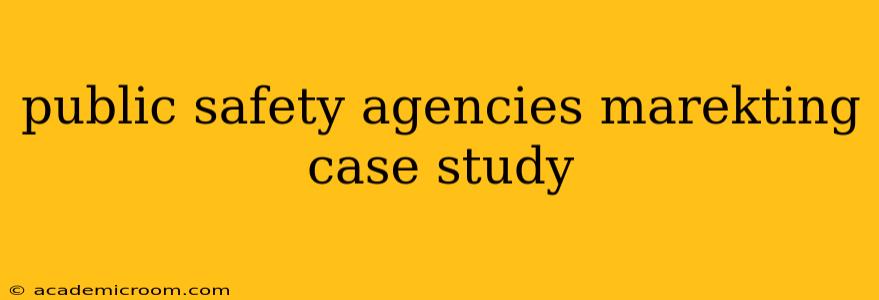Public safety agencies face a unique challenge: marketing essential services without resorting to fear-mongering or appearing self-promotional. Effective marketing for these agencies is less about selling a product and more about building trust, fostering preparedness, and ultimately, saving lives. This case study will examine successful strategies employed by various public safety agencies, highlighting key learnings and best practices.
The Challenge: Balancing Public Service with Marketing
Public safety agencies, encompassing fire departments, police departments, emergency medical services (EMS), and disaster relief organizations, operate under a different set of constraints than commercial businesses. Their primary goal isn't profit, but community safety and well-being. Therefore, their marketing efforts must prioritize:
- Building trust and credibility: Citizens need to believe in and rely on their local public safety agencies.
- Promoting preparedness: Encouraging proactive measures, like creating emergency plans and assembling preparedness kits.
- Educating the public: Providing clear and accessible information about safety procedures and emergency services.
- Improving community relations: Fostering positive relationships between the agencies and the population they serve.
- Recruiting and retaining qualified personnel: Attracting and keeping skilled professionals is crucial for maintaining public safety.
Case Study Examples: Diverse Approaches to Effective Communication
Several public safety agencies have successfully employed innovative marketing strategies. Let's examine a few examples:
1. Community Engagement through Social Media: Many agencies utilize social media platforms like Facebook, Twitter, and Instagram to connect with their communities. This allows for real-time updates on emergencies, sharing of safety tips, and engaging with citizens directly. Successful strategies involve consistent posting, interactive content (polls, Q&A sessions), and responding promptly to comments and concerns.
2. Targeted Public Service Announcements (PSAs): PSAs are a mainstay of public safety marketing. However, effective PSAs require careful planning and execution. Successful examples focus on specific, relatable scenarios and utilize emotional storytelling to create an impact. Data-driven targeting is also crucial, ensuring the right message reaches the right audience at the right time.
3. Partnership Marketing and Collaboration: Public safety agencies often benefit from collaborating with other organizations, such as schools, community centers, and local businesses. Joint initiatives, like community safety events or educational programs, can significantly increase reach and impact.
4. Data-Driven Insights and Evaluation: Modern marketing relies on data. Analyzing website traffic, social media engagement, and the effectiveness of different campaigns allows agencies to refine their strategies and maximize their resources. This iterative approach helps to continually improve the impact of their communication efforts.
Frequently Asked Questions (FAQs):
How can public safety agencies measure the success of their marketing campaigns?
Measuring success involves a multi-faceted approach. Agencies can track website traffic, social media engagement, and feedback from community surveys. More importantly, they can assess changes in public awareness, preparedness levels, and reported incidents. For example, an increase in preparedness kit ownership following a campaign could be a strong indicator of success.
What are some cost-effective marketing strategies for public safety agencies?
Cost-effective strategies often leverage free or low-cost channels, including social media, email marketing, partnerships with local media, and community events. Collaborating with local businesses or influencers can also expand reach without significant financial investment.
How can public safety agencies avoid fear-mongering in their marketing efforts?
The key is to focus on empowerment and preparedness, rather than fear. Instead of highlighting worst-case scenarios, messaging should emphasize proactive steps individuals can take to protect themselves and their families. This approach builds trust and encourages positive engagement.
How can public safety agencies address misinformation and rumors circulating on social media?
A proactive approach is essential. Agencies should establish clear communication channels and actively monitor social media for misinformation. Prompt, accurate, and transparent responses help to counteract false information and maintain public trust.
Conclusion: A Proactive and Community-Focused Approach
Effective marketing for public safety agencies is a continuous process of building trust, fostering preparedness, and communicating vital information to the community. By embracing innovative strategies, data-driven insights, and a strong focus on community engagement, these agencies can effectively reach their target audiences and ultimately, make their communities safer. The focus should always be on improving safety outcomes, measured by a reduction in incidents, improved community preparedness, and enhanced public trust.
